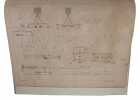6 books for « le verrier urbain jea... »Edit
LE VERRIER, URBAIN JEAN JOSEPH. - A CONFIRMATION OF THE GENERAL THEORY OF RELATIVITY.
Reference : 42922
(1843)
Recherches sur L'Orbite de Mercure et sur ses Pertubations. Détermination de la Masse de Vénus et du Diamètre du Soleil"
(Paris, Imprimerie de Bachelier), 1843. 4to. No wrappers as extracted from ""Journal de Mathématiques pures et appliquées...Publié par Joseph Liouville"", tome VIII. Pp. 273-360. Clean and fine.
First appearance of Le Verrier's provisional theory on the motion of Mercury, his studies of which eventually did much to demonstrate the validity of Einstein's Theory of Relativity. The planetary orbits should agree with the predictions of the General Theory of relativity, but as Einstein pointed out in his ""Erklärung der Perihelbewegung des Merkurs aus der allgemeinen Relativitätstheorie"" from 1915, the divergences predicted were too small to be observed, except in the case of the nearest planet Mercury, where the perihelion advance, according to the formula, reaches the value of 43"""" per 100 years, being in full agreement with the calculations of Le Verrier, who found this unexplained rest in the perihelion advance of Mercury per century, if the perturbations due to the other planets are deduced.- Einstein tells in a letter to a friend that for several days he was in a 'state of delirious joy' by this wonderful astronomical confirmation of his theory.""Le Verrier first began to study Mercury on the suggestion of Arago in 1840. Astronomers realized that Mercury's perihelion (the point at which the orbit of a planet is closest to the sun) advanced along its orbit at a rate of 566 seconds per century. Le Verrier calculated that, even when taking into account the forces exerted by other planets in the solar system, there still existed a discrepancy between calculation and observation. Le Verrier's accurate calculations showed that the planet's perihelion...did indeed advance forty seconds of an arc per century more than could be accounted for by Newton's theory of gravitation, even after the minor pertubing effects of the other planets had been allowed for."" (Asimov). - Le verrier published these findings in the present work, carefully as to the mass of the planet, comparison with other orbits of planets and their perihelia. At the time, Le Verrier put down the discrepancy to mis-observation or mis-calculation.- Sparrow, Milestones of Science No. 133.
Recherches sur L'Orbite de Mercure et sur ses Pertubations. Détermination de la Masse de Vénus et du Diamètre du Soleil" - [A CONFIRMATION OF THE GENERAL THEORY OF RELATIVITY]
(Paris, Imprimerie de Bachelier), 1843. 4to. Recent blue boards. 87, (1) pp. Clean and fine. In ""Journal de Mathématiques pures et appliquées"", tome VIII.
Scarce first separate edition of Le Verrier's provisional theory on the motion of Mercury, his studies of which eventually did much to demonstrate the validity of Einstein's Theory of Relativity. The separate edition - as we have it here - is paginated 1-87, while the periodical version is paginated 273-359.The planetary orbits should agree with the predictions of the General Theory of relativity, but as Einstein pointed out in his ""Erklärung der Perihelbewegung des Merkurs aus der allgemeinen Relativitätstheorie"" from 1915, the divergences predicted were too small to be observed, except in the case of the nearest planet Mercury, where the perihelion advance, according to the formula, reaches the value of 43"""" per 100 years, being in full agreement with the calculations of Le Verrier, who found this unexplained rest in the perihelion advance of Mercury per century, if the perturbations due to the other planets are deduced.- Einstein tells in a letter to a friend that for several days he was in a 'state of delirious joy' by this wonderful astronomical confirmation of his theory.""Le Verrier first began to study Mercury on the suggestion of Arago in 1840. Astronomers realized that Mercury's perihelion (the point at which the orbit of a planet is closest to the sun) advanced along its orbit at a rate of 566 seconds per century. Le Verrier calculated that, even when taking into account the forces exerted by other planets in the solar system, there still existed a discrepancy between calculation and observation. Le verrier's accurate calculations showed that the planet's perihelion...did indeed advance forty seconds of an arc per century more than could be accounted for by Newton's theory of gravitation, even after the minor pertubing effects of the other planets had been allowed for."" (Asimov). - Le verrier published these findings in the present work, carefully as to the mass of the planet, comparison with other orbits of planets and their perihelia. At the time, Le Verrier put down the discrepancy to mis-observation or mis-calculation.- Sparrow, Milestones of Science No. 133.
"LE VERRIER, URBAIN JEAN JOSEPH. - PREDICTING THE EXISTENCE OF THE PLANET NEPTUN.
Reference : 46890
(1846)
Paris, Bachelier, 1846. 4to. No wrappers. In: ""Comptes rendus hebdomadaires des séances de l’Académie des sciences"", Vol. 23, No 9 (entire issue offered). With htitle and titlepage to vol. 23. Pp. 425-484. Le Verrier's paper: pp. 428-438.
First printing of this important paper in the history of astronomy in which Le Verrier predicted the existence of a new planet, determining its orbit and the mass as well as its actual position, so that, by informing Dr. Galle the following month, where he should look for it in the sky. The same evning when Galle had received the letter, he found close to the position given by Le Verrier a strange body showing a small planetary disc, which was soon recognized as a new planet, known now as Neptune. Adams in England, independently made the same prediction.""Until 1846 there was no theory of Uranus that permitted its movements to be represented satisfactorily. In 1821 Bouvard had constructed tables that, abandoning the older positions, adhered very closely to recent observations. Yet twenty years later a discrepancy of two minutes had already been observed, and several astronomers suggested that it might result from the attraction of an unknown planet. In 1845 Arago presented the problem to Le Verrier, who began by establishing a precise theory of Uranus. He then demonstrated that its observed perturbations could not be explained as the effect of the actions of Jupiter and Saturn, whatever modifications might eventually be made in the values assigned to the masses of those planets. He began to search for signs of an unknown disturbing planet. Finally, in a third memoir on the subject, appearing on 31 August 1846, Le Verrier fixed the exact position of the unknown planet and gave its apparent diameter.""(DSB)
"LE VERRIER, URBAIN JEAN JOSEPH. - THE FIRST STEPS TOWARDS DISCOVERING NEPTUNE.
Reference : 48802
(1845)
Premier Mémoire sur la théorie d'Uranus.
(Paris, Bachelier), 1845. 4to. No wrappers. In: ""Comptes rendus hebdomadaires des séances de l’Académie des sciences"", Vol. 21, No 19. Pp. (1009-) 1082 (entire issue offered). With titlepage to vol. 21. Le Verrier's paper: pp. 1050-1055. Stamp to top of titlepage.
First appearance of Le Verrier's first paper on the anomalities in the orbit of Uranus, the calculations on which eventually leading to his prediction and discovery of a new planet, Neptune the following year, 1846.
"LE VERRIER (LEVERRIER), URBAIN JEAN JOSEPH. - THE EXISTANCE OF NEPTUNE PREDICTED.
Reference : 47206
(1846)
Recherches sur les mouvements d'Uranus. (Séance du Lundi 1er Juin 1846).
Paris, Bachelier, 1846. 4to. No wrappers. In: ""Comptes Rendu hebdomadaires des Séances de l’Académie des Sciences"", Vol. 22, No 22. Pp. (893-) 928. (Entire issue offered). Le Verrier's paper: pp. 907-018.
First appearance of Le Verrier's paper in which he postulated the existance of a new planet on mathematical premises from the gravitational disturbencies of Uranus.""In 1846 John Cauch Adams... and Urban J. Leverrier... simultaneously and independently determined the location of a possible new planet... In 1845 he wrote of his findings of the mathematical location of a new planet to Sir George Bidell Airy,,, Because Adams was unknown, his letter was put aside. Meanwhile the same perturbations of Uranus had become of interest to Leverrier. On July 1(should be June !), 1846 he presented a paper ""Recherches sur les mouvements d'Uranus"" (the paper offered) to the Academie des Sciences inParis. When Airy realized that Leverrier and Adams had reached the same conclusions, he hastened to suggest that a search be made for the newplanert. Shortly hereafter it was seen bur not recognized. About a week before it was found in England, it was discovered by Galle in Berlin on information supplied by Leverrier. Thus, the honour of the discovery, or even co-discovery of the new planet, Neptune, was lost to Adams and credited to Leverrier.... Adams paper was reade before the Royal Astronomical Society, November 13, 1846, and was published in 1847. (Milestones p. 40).Milestones of Science No 132. - Dibner No. 16.
"LE VERRIER (LEVERRIER), URBAIN JEAN JOSEPH. - PREPARING FOR, PREDICTING AND CONFIRMING THE EXISTENCE OF NEPTUNE.
Reference : 49635
(1845)
Premier Mémoire sur la théorie d'Uranus. (Séance 10 Novembre 1845). (+) Recherches sur les mouvements d'Uranus. (Séance du Lundi 1er Juin 1846). (+) Sur la planète qui produit les anomalies observées dans le mouvement d'Uranus. Détermination de ...
Paris, Bachelier, 1845 a. 1846. 4to. No wrappers. In: ""Comptes rendus hebdomadaires des séances de l’Académie des sciences"", Vol. 21, No 19, Vol. 22, No 22, Vol. 23, Nos 9, 14, 16 a. 17. (6 entire issues offered). Le verrier's papers: pp. 1050-1055 (No 19), pp. 907-919 (no 22), pp. 428-438 (No 9), pp. 657-659, 659-643, 676 (No 14), pp. 741, 741-754, 754 (No 16), pp. 798-799, 799-800 (No 17). With title-pages to vol. 21,22 a. 23. Titlepages with a small stamp in upper corner and a perforated stamp to lower margin. Light yellowing to title-pages, otherwise clean and fine on good paper.
First printing of Le Verrier's importent and famous papers, predicting and confirming the discovery of the Planet Neptune, including the ""preparatory"" paper, the first paper on the anomalities in the orbit of Uranus, the calculations on which eventually leading to his prediction and discovery of a new planet, Neptune the following year, 1846.""In 1846 John Cauch Adams... and Urban J. Leverrier... simultaneously and independently determined the location of a possible new planet... In 1845 he wrote of his findings of the mathematical location of a new planet to Sir George Bidell Airy,,, Because Adams was unknown, his letter was put aside. Meanwhile the same perturbations of Uranus had become of interest to Leverrier. On July 1(should be June !), 1846 he presented a paper ""Recherches sur les mouvements d'Uranus"" to the Academie des Sciences inParis. When Airy realized that Leverrier and Adams had reached the same conclusions, he hastened to suggest that a search be made for the newplanert. Shortly hereafter it was seen bur not recognized. About a week before it was found in England, it was discovered by Galle in Berlin on information supplied by Leverrier. Thus, the honour of the discovery, or even co-discovery of the new planet, Neptune, was lost to Adams and credited to Leverrier.... Adams paper was reade before the Royal Astronomical Society, November 13, 1846, and was published in 1847. (Milestones p. 40).Milestones of Science No 132. - Dibner No. 16.
 Write to the booksellers
Write to the booksellers








